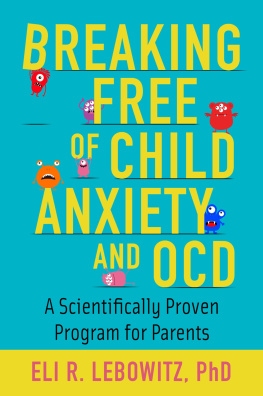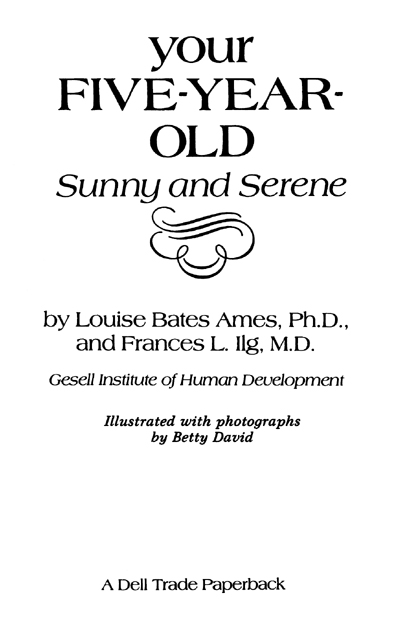A Dell Trade Paperback
Published by
Dell Publishing
a division of
Bantam Doubleday Dell Publishing Group, Inc.
1540 Broadway
New York, New York 10036
Copyright 1979 by The Gesell Institute of Child Development, Louise Bates Ames and Frances L. Ilg
All rights reserved. No part of this book may be reproduced or transmitted in any form or by any means, electronic or mechanical, including photocopying, recording, or by any information storage and retrieval system, without the written permission of the Publisher, except where permitted by law.
For information address Delacorte Press, New York, New York.
The trademark Dell is registered in the U.S. Patent and Trademark Office.
eISBN: 978-0-307-80897-4
Reprinted by arrangement with Delacorte Press
v3.1
CAN
YOUR FIVE-YEAR-OLD
MAKE YOU A HAPPIER, LESS STRESSED, AND MORE EFFICIENT PARENT? YOU BET! FIND OUT ABOUT
The major behavior change to expect at Five-and-a-half it may be a shock to a parent with a once good-as-gold child, but you can handle it wisely if you know how. See .
Fears and tears witches, scary movies, dark closets, or thunder can bring a bout of crying. Find out what will send the monsters away. See .
Thumb-sucking is this a tension reliever or a problem? Find out the smartest response a parent can make. See .
Discipline the six best techniques for achieving behavior you truly wantwithout resorting to screaming or spanking. See .
Encouraging creativity twelve activities you can initiate to stimulate your childs natural talents and have a great time too! See .
Reading readiness the single most important thing to remember about reading (and writing too). See .
and more!
YOUR FIVE-YEAR-OLD
I think [these books] are delightful and likely to capture the imagination of young parents enough to get them through these years. I think the books will be both a pleasure and support for many parents.
T. Berry Brazelton, M.D., author of Toddlers and Parents and Infants and Mothers
These are cheerful, optimistic books. I agree with just about everything they say.
Lendon Smith, M.D., author of Feed Your Kids Right
Books from the Gesell Institute of Human Development
YOUR ONE-YEAR-OLD
Ames, Ilg, and Haber
YOUR TWO-YEAR-OLD
Ames and Ilg
YOUR THREE-YEAR-OLD
Ames and Ilg
YOUR FOUR-YEAR-OLD
Ames and Ilg
YOUR FIVE-YEAR-OLD
Ames and Ilg
YOUR SIX-YEAR-OLD
Ames and Ilg
YOUR SEVEN-YEAR-OLD
Ames and Haber
YOUR EIGHT-YEAR-OLD
Ames and Haber
YOUR NINE-YEAR-OLD
Ames and Haber
YOUR TEN- TO FOURTEEN-YEAR-OLD
Ames, Ilg, and Baker
To our daughters,
Joan and Tordis, and our grandchildren,
Carol, Clifford, Douglas, Karl, Mark,
Tommy, and Whittier
CONTENTS
FOREWORD
Norms, or descriptions, of what a parent may expect his or her child to do at any given age make some people feel secure. They make other people anxious or even angry. But we have found that most parents do seem to find it comforting to know more or less what they may expect of their child at any given age.
Many find it especially comforting when their child is going through a difficult or demanding stage to learn that it is all very normalthat other children behave in these ways too.
We ourselves have been studying child behavior for the past fifty years or more and our own studies were preceded by those of Dr. Arnold Gesell, the Director of our former Clinic at Yale, in whose honor our present Institute was founded.
All these studies, which have involved literally thousands of boys and girls, have convinced us that human behavior develops in a highly patterned way. It seems quite possible to describe rather clearly the more or less predictable stages through which any kind of behaviormotor, language, adaptive, personal-socialdevelops.
We can tell you with high confidence what the stages of development will be in the more or less average boy or girl.
But of course hardly anybody is truly average. As we shall describe in rather great detail in Chapter Nine of this book, every child is an individual, different in many ways from every other child livingeven from his or her own identical twin.
So when we tell you that Four is wild and wonderful, Five is calm and serene, Six something else again, this does not mean that all children at any one of these ages will behave or should behave just exactly in the ways we describe.
Some perfectly normal boys and girls will be ahead of our schedule. Some will be behind, and then, of course, there are those who will hit it right on the nose. And it is certainly not a cause for concern in any case.
Not only will there be many differences in timing, but also in level of equilibrium or disequilibrium. Some children, at all ages, are charmingly well adjusted, easy to live with. Others, no matter how skillful and caring their parents, may be difficult at any stage of childhood, or at all.
Some children seem to develop in a fairly integrated way. All the different kinds of behavior occur rather evenly. So they will be right at, or above, or below their age in motor, adaptive, language, and what we call personal-social behavior. Others may be way ahead of customary expectations in their talking but below age in motor ways. Or just the opposite.
We have described the kinds of individual differences we expect later in this book. But so that no reader will be made anxious by what we say, let us emphasize right here at the very beginning that the descriptions of expected behaviors which we give are only averages, generalizations, ways that many of the children we see do conduct themselves.
We have sometimes likened the descriptions we give in this and other similar books to a map of a country through which you may plan to travel. We can tell you what the country is like. We cannot tell you what your trip will be like. You may go faster or slower than the usual traveler. You may take more side excursions than the average. You may even at times backtrack. The map does not guarantee what you will do or even tell you what you ought to do. It merely defines the territory.
Most people find maps quite useful. Many parents find our maps of the terrain of child behavior useful, too. So use our maps if you like and we hope that you will find, as do many, that they provide helpful orientation. Please do not use them for comparing your own child with our hypothetical average and then making adverse judgments either about our norms or about your child. Each child is a wonderfully unique and special person. We hope only to help you appreciate him more as he passes through his various stages of development.
chapter one
CHARACTERISTICS OF AGE FIVE
What can you as a parent expect of your Five-year-old boy or girl? It is a pleasure to tell you that with most Five-year-olds, some very good times are ahead. Five wants to be good, means to be good, and more often than not succeeds in being good.
Perhaps most delightful of all his characteristics is that he enjoys life so much and looks so consistently on its sunny side. Today is my lucky day, he will tell you as he jumps out of bed in the morning. Or, enthusiastically, Today Im going to do all the good things and none of the bad things. Or even more comprehensively, I want to be good all the time and not do any of the bad things. Ill do whatever you say and I wont make a fuss.











